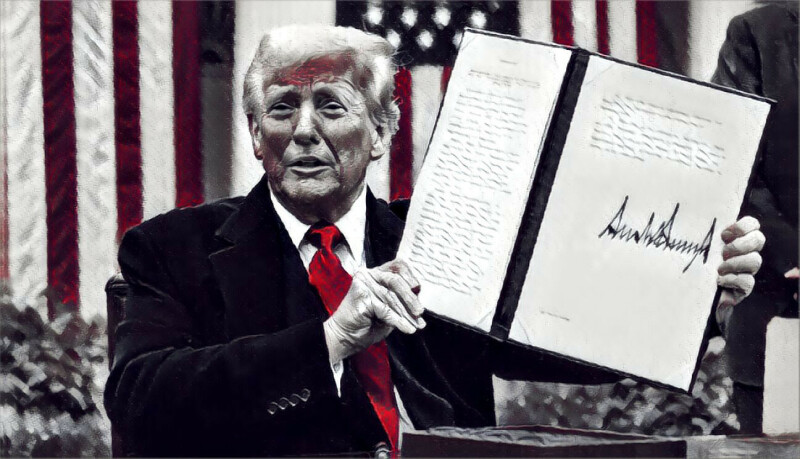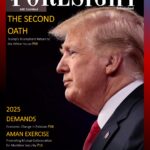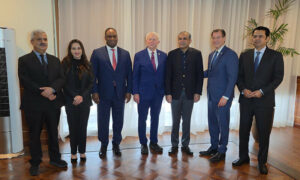Pakistan now faces a 29pc tariff on its exports to the US, significantly higher than the 10pc baseline.
On Wednesday, President Donald Trump, in a bid to give the US “great power to negotiate”, imposed 10 per cent tariffs on all countries — set to take effect on April 5 — igniting fears of steep price increases in the world’s largest consumer market.
He further individualised reciprocal penalties on various countries, to be imposed from April 9. These penalties can raise tariffs to levels unseen since the end of the Second World War.
The newly applied tariff rates by the Trump administration have created significant controversy as experts around the world not only doubt the methodology of its application but also its purpose. It is widely believed that these penalties are likely to trigger tariff wars that will not only be detrimental to the US but also to the world economy.
The US is by far the largest importer in the world and the most important export destination for several of its trading partners. These tariffs will have implications on the economic conditions of its trading partners as they will surely struggle to provide competitively priced products to the US consumers.
Among these trading partners is also Pakistan, now facing a 29pc tariff rate on its exports to the US. This is significantly higher than the 10pc baseline but lower than the levels imposed on several of its South and East Asian neighbours. Islamabad’s exports to Washington are dominated by textile products, as is the case with Pakistan’s several other counterparts.
Breaking it down
The tariff rates determined by the Trump administration account for two things: the trade deficit between the US and its trading partners and the level of imports coming into the US from its trading partners. Because of this, several countries that run a trade surplus with the US are being heavily penalised, while countries with which the US runs a balanced trade face tariff rates close to 10pc.
In essence, the purpose of these tariffs is to discourage trading partners from running a large trade surplus and instead achieve a balance by complementing exports to the US with imports from it.
Conventionally, the tariff rates on US imports have been lower than those imposed by trading partners on exports from the US. Exporters face higher tariff rates in exporting their products from the US relative to their foreign counterparts exporting their products to the US. This is the argument presented by the Trump administration as it pushes for higher tariffs on its trading partners. However, the retaliatory tariffs are much higher than those imposed by their trading partners.
The revised tariffs to be charged by the US were calculated by determining the ratio of the trade deficit with each trading partner to the imports into the US from it. The higher the trade deficit, given the level of imports into the US from the trading partner, the higher the tariff charged to the US. This method aims to account for non-tariff barriers that hinder trade for US exporters. Therefore, Pakistan, with a trade balance of $3.3 billion in 2024 and exports to the US worth $5.5bn, faces a tariff rate of approximately 60pc. The Trump administration has discounted this rate by 50pc and imposed a reciprocal tariff of approximately 30pc on imports from Pakistan.
This policy considers exports and imports to be complementary; an increase in imports into the US from a trading partner must accompany an increase in exports from the US to the trading partner. The reciprocal tariffs in Figure 2 are significantly higher than the tariffs imposed on US exports by trading partners in Figure 1.
Exports to the US from its respective trading partners as a percentage share in total exports is presented in Figure 3. More than a quarter of the total exports of Viet Nam and Cambodia are destined to the US, while this share falls below 20pc for the remaining four countries. However, the US remains the top single-country export destination for China, India and Pakistan. It is the second largest export destination for Bangladesh, following Germany.
While textile products constitute the majority of the exports from Pakistan and Bangladesh, the share of their textile exports to the US in total textile exports is limited as compared to Viet Nam and Cambodia. More than 40pc of the textile exports from Viet Nam and Cambodia are destined for the US. Therefore, textile exports from Viet Nam and Cambodia are likely to face a greater impact from the reciprocal tariffs than their counterparts.
More than $9bn worth of raw cotton was exported from the US in 2022, which was approximately 30pc of total textile exports from the US. It is by far the largest exporter of raw cotton in the world, exporting more than 2.5 times the amount exported by the second largest exporter, Brazil, in 2022. Although the US runs a trade deficit in the textile industry of more than $90bn, it runs a trade surplus in the export of raw cotton. This is likely to create a potential linkage between the exports and imports in the textile industry, as policymakers around the world may implement measures to reduce the trade surplus with the US.
According to the United Nations ESCAP’s RIVA Value Chain Analyzer — an online tool for policy makers, analysts and researchers to better understand their economy’s integration in global value chains — approximately 18pc of the gross exports of the US in the textile sector is returned via exports of its trading partners. This not only highlights the importance of participation in value chains but also provides opportunities to negotiate tariff concessions with the US based on the level of their content used in producing the final products.
Pakistan was the second largest destination after China, with over 15pc of the total exports of raw cotton from the US destined to it. This was approximately 3pc in 2015. On the other hand, the share of Bangladesh and India has remained less than 10pc.
Implications for Pakistan
As outlined above, Pakistani exporters are likely to face significantly higher tariffs on their exports to the US. However, the impact of tariffs is likely to be lower relative to some of its counterparts in South Asia and East Asia.
Having been imposed with the purpose of reducing bilateral trade deficit of the US with its trading partners, these tariffs will compel Pakistani policymakers to consider linkages between exports and imports across various industries to ensure that exports to the US do not decrease as a result, particularly because the foreign exchange accumulation is an utmost priority.
Hence, it will be essential for Islamabad to encourage firms to participate in value chains involving US imports and converting those imports into exportable output for the US and other countries. The demand for imports from the US is likely to increase globally as other countries are likely to adopt strategies to reduce their trade surplus with the US. This will require firm-level strategies that must enhance their capacities and capabilities so that such imports are converted into exports rather than used as inputs for domestic consumption.
This is indeed a daunting task, but one that is necessary if Pakistan must achieve its export targets as envisioned under the recent economic transformation plans.











